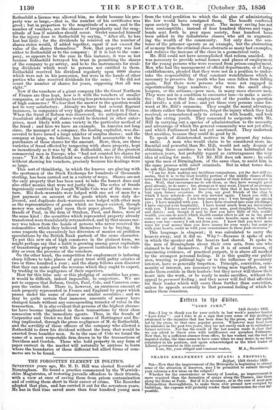THAMES RIEBANKRENT AND QUAYS: A PROPOSAL. Belfast, 15th October 1856.
Sm—Now that the improvement of the Metropolis is beginning to attract some of the attention it deserves, may I be permitted to submit through your columns a few ideas on the subject?
Whether for the convenience or beauty of London, no improvement is more required than the formation of quays along the Thames, like those along the Seine at Paris. But if it is necessary, as in the case of most new Metropolitan thoroughfares, to make them over ground now occupied by buildings, the expense will probably render their construction for ever im- possible. I believe, however, that their construction may be accompanied by a gain instead of a loss of afilding-ground, and an increase in the value of wharf
PrWrtY• ese objects are to be attained by building the quays on ground which is now occupied only by the bed of the river, and is in many places left bare and unsightly at low-water. An embankment should rise from the bottom of the river, to the height above the water most convenient for wharfs. A clear space of about fifteen feet in width should be allowed at the water's edge for wharfs ; and behind these should be a row of arches, bearing the roadway of the quays, and serving as sheds for goods and as entrances to the wharfs from the land side. The roadway of the quays should be on a level with the bridges, and in direct communication with them.
By this plan, the roadway of the quays would occupy no ground-space, any more than the bridges occupy water-space ; and all the ground re- claimed by the embankments from the river would be available for building and wharf purposes. It is consequently very probable that such a work would prove highly remunerative to a company undertaking it. The laud side of the quays would present a succession of the finest building-sites in the world : and the value of the wharf property would be greatly increased by carrying the wharfs out into deeper water; for it would then be practicable, by means of steam lighters, to land cargoes above as well as below London Bridge, and thus virtually to enlarge the seaport of London.
The quays ought to be wide enough for all ordinary traffic, and in addi- tion, for a double line of railway for omnibuses to be worked by horses. Such railways are in successful operation in Paris and New York. They probably cannot be introduced into the existing streets of London, except under favourable conditions of width and level, which do not exist where such railways are most needed to relieve the present crowded traffic : but there could be no objection to them in new, wide, and level thoroughfares like the proposed quays, where they would be at once a great public benefit and a large source of income to the company constructing them.
So vast a work could not, of course, be all undertaken at once. The best place to commence would probably be between London Bridge and Black- Mars Bridge on the City side : after completing the works there, the com- pany might sell the building-ground and wharfs, and commence similar works above 13bn-di-friars Bridge. By this method of proceeding, a com- paratively small capital would suffice in a series of years to complete the vast work of the embankment of the Thames.
The arches on which I propose to carry the roadway of the quays need not be of great width ; and the abutments would not rise out of the water, but out of the embankment which is to have the wharfs at its edge. These arches and abutments need not consequently be built in so expensive a man- ner as those of the bridges ; and might be built probably, with great economy of Caterham stone, which is soon to be supplied in London at a cheap rate by railway.
Of course what I have said of the desirableness of building-sites along the river implies that the river is to be purified : but I hope there is now a fair prospect of this most desirable improvement.
Yours respectfully, • J. J. M.



























 Previous page
Previous page